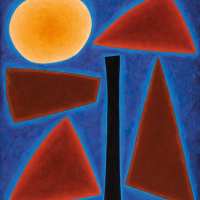36. JOHN COBURN

The effect is stunning, almost bewildering, a combination of visual impressions and emotional responses that challenge categorisation, that have a beauty and calm about them that is simple as it is intricate, as obvious as it is mysterious.1
During his long and productive career, John Coburn developed his own personal iconography that has ascribed to him a significant place within Australian art history. In depicting the beauty of nature and spirituality in the landscape, Coburn has refined a subtle yet powerful unique symbolic language that today defines his remarkable oeuvre. His works include exquisite paintings, tapestries and screenprints.
Coburn essentially works in a non-figurative manner and through his art explores a spiritual relationship with the landscape and with the beauty of nature. Coburn also expresses his passion for music, in particular, Jazz, through his art. Both nature and music are not transcribed literally through his painting but are catalysts to achieving a presentation of a higher state.2
When discussing the Singing the Blues series and the related painting, Mellow Yellow, biographer Nadine Amadio describes the works, The colour adventure of these two works almost constitutes an optical illusion. In Singing the Blues II, the electricity of the blue background and the dark shapes shimmer with their own music. The works also reveal his great love of jazz. Although Coburn is not a musician himself, (he confesses to playing the mouth organ as a boy) his interest in both classical music and jazz is wide, as is his interest in all the arts. Coburn is attracted to the driving life-force of rhythm and improvisation in traditional jazz. He has transposed these qualities to his work in the dynamic arrangement of the shapes that really provides the content of these paintings. I know a number of jazz musicians and they have always responded to my paintings and said how much they were like jazz. Singing the Blues is reminiscent of paintings I was doing four or five years earlier where I used just a few simple shapes on a large surface.3
In an extraordinary career, spanning some six decades, Coburns accolades were many. Most notably he was awarded the prestigious Blake Prize for religious art in 1960 and again in 1977. In 1980 he was awarded Member of the Order of Australia in recognition of service to art. Undoubtedly he is best known by many Australians for his 1970 commission to design the great tapestry curtains for the Sydney Opera House, Curtain of the Sun and Curtain of the Moon.
Coburn is represented in the National Gallery of Australia, all state galleries, many regional galleries, and other public collections in Australia and overseas, including Graphische Sammlung Albertina, Vienna; the John F Kennedy Centre, Washington; and the Vatican Museum, Rome.
Footnotes
1. Peter Skrzynecki cited in Kolenberg, J., John Coburg, Australian Galleries, Sydney and Melbourne, 2000, p.5 (exhibition catalogue)
2. Grishin, S., John Coburn and his Vision of the Australian Landscape, cited from John Coburn: Recent Work 2001, Australian Galleries, Melbourne, June 2001 (exhib. cat.)
3. Amadio, N., John Coburn: Paintings, Craftsman House, Sydney, 1988, p.164
Caroline Jones MArtAdmin